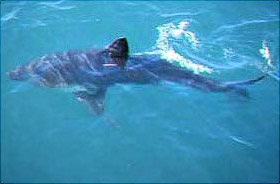
Lamna ditropis
These sharks are often mistake for white sharks because they look very similar, but the salmon shark is dark blue-gray to black over most of its body, except for its pale underside which often has dark blotches on it that the white sharks do not. They can get to 10 feet long (almost 1,000 pounds) from their short, conical snouts to their crescent caudal (tail) fins. Unlike most others, this shark is endothermic, meaning it is able to maintain a body temperature above the temperature of the surrounding water.
Order: Lamniformes
Family: Lamnidae
Genus: Lamna
Species: ditropis
Common Names
The salmon shark gets its name from one of its prey items, the Pacific salmon (Oncorhyncus spp.). Although it is considered to be one of the main predators of Pacific salmon, the salmon shark is actually an opportunistic feeder with a wide-ranging diet.
The salmon shark was called the porbeagle before it was recognized as a separate species. It belongs to the family Lamnidae, the mackerel sharks. In French, the salmon shark is known as requin-taupe saumon, in Spanish, marrajo salmón, and in German, Pazifischer Heringshai. The salmon shark is abundant in Japanese waters, and it has several local names in Japan, including the Japanese mackerel shark, nezumizame, mokazame, radukazame, and sakezame.
Importance to Humans
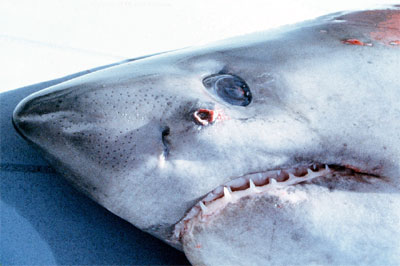
The salmon shark is not specifically targeted by commercial fisheries, but is often caught as by-catch in Japanese, United States, and Canadian offshore gill-netting, seining, and trolling for salmon, swordfish, and thresher sharks. It is also sometimes caught by trammel-netting halibut fishers off California. Salmon sharks are commonly viewed by fishermen as pests because of the heavy damage they do to fishing gear.
When salmon sharks are caught, the fins of the salmon shark may be harvested, but the carcass is generally discarded. However, if harvested, the flesh is sold for consumption in Japan, and to a lesser extent in the U.S. The oil, skin (leather), and fins (soup) may also be used. The people of the northern Japanese fishing port of Kesennuma, where most salmon shark landings in Japan occur, also use the heart in a popular local sashimi dish.
There is some recreational fishing for salmon sharks in Alaskan and Canadian waters.
Danger to Humans
The salmon shark is generally viewed as potentially dangerous to man. However, even though it is a relatively large shark and is related to infamously dangerous species like the white shark (Carcharodon carcharias) and the shortfin mako (Isurus oxyrinchus), it has never been positively identified in any shark attack. The unsubstantiated reports of this species are probably due to confusion with the white shark. Divers have viewed groups of salmon sharks underwater with no reports of agonistic behavior by the sharks.
Conservation
> Check the status of the salmon shark at the IUCN website.
The IUCN is a global union of states, governmental agencies, and non-governmental organizations in a partnership that assesses the conservation status of species.
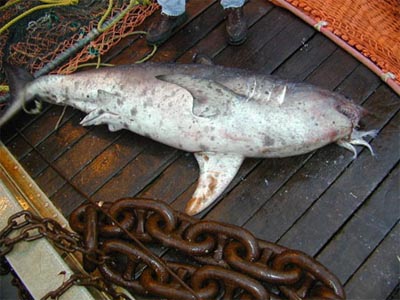
Fishery statistics for this species are very limited, but as recent studies indicate low fecundity and slow maturity, it may be quite vulnerable. Unfortunately, there is no regulation on the pelagic fishery in international waters, and the salmon shark is actually very heavily fished as bycatch, although often discarded. In general, fishermen view the salmon shark as a pest because of its frequent damage to fishing gear, particularly in salmon fisheries, and this means the shark is all the more likely to be killed or traumatized.
The recent frequent strandings of juvenile sharks along the Pacific coast of the U.S., which were rare in the 1970s and 1980s, indicate a possible adverse reaction to human development impacts along the coastal waters that are a nursery for this species.
Due to the lack of biological knowledge of the salmon shark and increased sports fishing for it, the Alaska Board of Fisheries closed all commercial shark fishing in Alaska state waters and imposed heavy regulations on the state sports fishery for salmon sharks in 1997.
Geographical Distribution
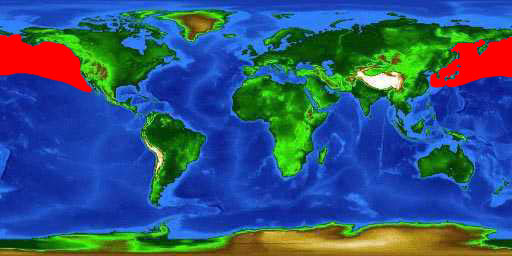
The salmon shark occurs only in the coastal and oceanic waters of the North Pacific. They can be found in the waters off Japan (including the Sea of Japan), off the western Pacific coasts of North Korea, South Korea, Russia (including the Sea of Okhotsk), and in the Bering Sea. The eastern portion of their range is bounded by the eastern Pacific coast of the Canada, the U.S., and possibly northern Mexico. Because the salmon shark only occurs in the Pacific, it can be easily distinguished from its relative the porbeagle, in the northern hemisphere, which only occurs in the Atlantic.
Habitat
The salmon shark is a primarily pelagic species, but can be found in epipelagic, offshore, and coastal areas. It appears to prefer cold boreal to cool temperate waters, but has been caught in water temperatures from 36.5° to 75°F (2.5° to 24°C). The species can be found at the surface to depths below 500 ft (152 m), and has been photographed at 837 ft (255 m).
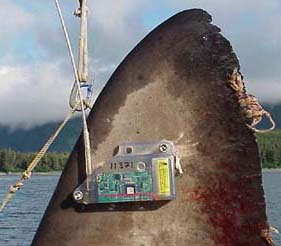
As is common among pelagic elasmobranch species, the salmon shark makes long oceanic migrations over the course of the year. In this species, these migrations appear to be highly correlated with
those of the pelagic fish that it principally preys on, as well as with reproductive seasons. The salmon shark gives birth in the spring and probably mates in the summer or autumn. Populations in the northwest Pacific breed in Japanese waters or in waters off the coast of Kamchatka and Sakhalin. In winter, when the water warms, they migrate north to more distant feeding grounds in the Sea of Okhotsk, the Bering Sea, and the Sea of Japan. In the spring, they return south to Japanese waters, areas of the open ocean, and the southern Kuril region, where the females give birth.
Populations of the northeast Pacific perform a similar north-south migration in the waters off California, Oregon, Washington, Alaska, and Canada. The females migrate south in the spring to give birth off Oregon and California, where a significant number of neonates and young juveniles are found beached at that time every year.
There appears to be a strong sexual segregation in this species with males dominating the western North Pacific and females dominating the eastern North Pacific. In fact, males and females probably do not form mixed groups, as catches of salmon sharks are almost always dominated by one sex or the other. Although trans-Pacific movements have not been documented, they are suspected to occur, particularly during the mating period, which is probably in summer or autumn.
Salmon shark populations also appear to be segregated by size, with large sharks generally inhabiting the more northern reaches of the species’ range, and smaller sharks staying in the southern parts. The larger, more mature sharks are more active in migrations, like the ones described above, while juveniles tend to remain in nursery areas until they reach about 3.6 to 3.9 ft (110 to 120 cm) in length. The waters off the coast of California appear to be a major nursery ground for the northeast populations, with juveniles remaining there for one to two years after birth. The northwest salmon shark populations have nursery grounds in the open-water Pacific, Japanese waters, and the southern Kuril region.
Biology
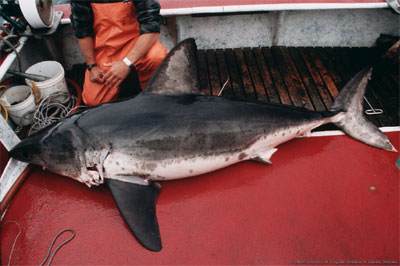
Distinctive Features
The salmon shark has a heavy spindle-shaped body with a short blunt conical snout. The gill slits are large. The caudal peduncle is strongly keeled, with short secondary keels on the caudal base. The caudal fin is crescent-shaped. The large first dorsal fin has a free rear tip. The small second dorsal and anal fins can pivot.
The salmon shark is sometimes mistaken for the white shark (Carcharodon carcharias), but it can be distinguished by its shorter snout and the presence of secondary keels on the caudal base (the white shark has none).
Coloration
The dorsal and lateral surfaces of the salmon shark are dark blue gray to black in color. Its dorsal fin is all dark, including the rear tip. The ventral surface of the snout anterior to the mouth is also dark, but the rest of the ventral surface of the body is white, often with dusky blotches (in adults only) and white patches over the pectoral bases. The dark blotches can also be used to distinguish the salmon shark from the white shark.
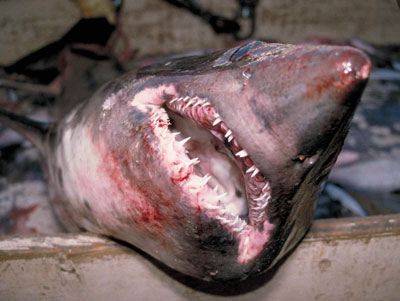
Dentition
The salmon shark has moderately large blade-like teeth with lateral cusplets, small bumps or “mini-teeth” on either side of each tooth. The first upper lateral teeth have oblique (diagonally-oriented) cusps.
Size, Age, and Growth
The salmon shark has a maximum total length of about 10 ft (305 cm) and maximum weight of over 992 lbs (450 kg). There are unconfirmed accounts of salmon sharks 12.1 to 14.1 ft (370 to 430 cm), but these may have resulted from confusion with the larger white shark. In the eastern North Pacific, female salmon sharks can live to at least 20 years, males to at least 27 years.
In the western North Pacific, males mature at about 5.8 to 6.1 ft (177-186 cm) in total length and 5 years, and females mature at about 6.6 to 7.3 ft (200-223 cm) and 8-10 years. Salmon sharks in the eastern North Pacific appear to have a faster growth rate than those in the western north Pacific and mature at an earlier age. In the eastern North Pacific, males mature at about 5.2 ft (158 cm) and 3-5 years, and females at 6.7 ft (205 cm) and 6-9 years. Also, females in the eastern North Pacific are in general larger and heavier bodied than those in the western North Pacific.
Thermoregulation
As with all other members of the family Lamnidae (the mackerel sharks), the salmon shark is endothermic, meaning it is able to maintain a body temperature above the temperature of the surrounding water. This is unusual because most fish are ectotherms, having internal temperature that is nearly identical to the ambient water temperature.
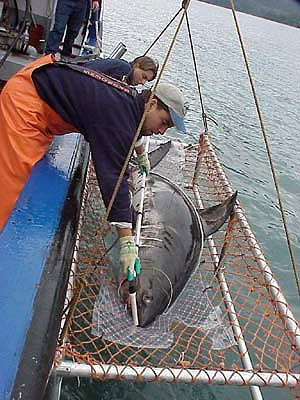
All lamnids have vascular counter-current heat exchangers (retia mirabilia) that allow them to retain the heat produced by the metabolism of these fast-swimming sharks. Salmon sharks have retes in the cranium near the eyes, in the locomotor muscles, and in the viscera. They also have vascular shunts that allow them to alter the route of blood flow, further regulating rates of heat gain and heat loss. A few other fast-swimming fish, like tunas, also have this homeothermic ability, so this is an instance of convergent evolution between lamnid sharks and tunas.
Recent studies have shown that the salmon shark does indeed maintain an internal temperature well above ambient water temperature. In fact, the salmon shark probably has the greatest thermoregulatory ability of any shark, and internal body temperatures up to 60.1°F (15.6°C) greater than sea surface temperature have been recorded.
This thermoregulatory ability allows salmon sharks to range vertically through the water column in search of prey and to extend their niche to boreal waters.
Food Habits
Salmon sharks are opportunistic feeders. Their diet consists mainly of pelagic and demersal bony fishes, such as Pacific salmon, steelhead trout, herring, sardines, pollock, Alaska cod, tomcod, lancetfishes, daggerteeth, sauries, lanternfishes, pomfrets, mackerel, lumpfishes, sculpins, etc. Non-bony fish prey include the spiny dogfish and pelagic squid. Salmon sharks may feed singly or in feeding aggregations of several sharks.
Salmon sharks are generally believed to be one of the principal predators of Pacific salmon (Oncorhyncusspp.), but some studies suggest this may only be true for certain populations in certain areas of the salmon shark’s range. In the Aleutian Islands and the Gulf of Alaska, for example, salmon shark abundance corresponds to catch rates of salmon, and the migration patterns of predator and prey appear to be linked. However, in the western North Pacific, most salmon sharks appear to be concentrated south of the salmon’s migration path. The migration patterns of these western North Pacific populations appear to be linked instead with those of herring and sardines.
Reproduction
Salmon sharks mate summer-autumn and give birth in the spring. During mating, the male shark bites the female to hold onto her while they copulate. Accordingly, biologists can tell if a female has recently mated by looking for fresh bite marks.
This shark’s gestation period is probably about nine months, with litters containing 2-5 embryos. It is ovoviviparous, meaning that it gives birth to live young, but in the uterus (womb), embryos have no placental or other direct connection to the mother. Oophagy, or consumption of unfertilized eggs by embryos, has been documented in this species. During gestation, the mother continues to ovulate unfertilized eggs (ova), which proceed from the ovary to the nidamental gland, where they are filled with yolk. These nutritive ova then pass to the uterus, where they are consumed by the growing embryos. This is how embryos are nourished during most of gestation. Embryos are born at about 2.8 to 3.1 ft (84-96 cm) in length.
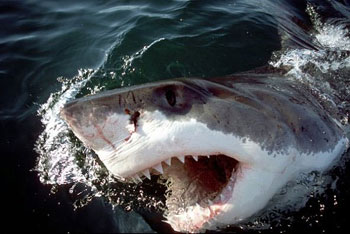
Predators
It is unlikely that any creature would prey on adult salmon sharks because of their size. However, juvenile salmon sharks probably do face predators among the larger fish, including other sharks, that inhabit their range.
Parasites
Because this species is so little studied, reports of parasites found in it are few. There is a record of the cestode (tapeworm) Nybelinia surmenicola found on a salmon shark in Alaskan waters.
Taxonomy
The salmon shark, Lamna ditropis, was first described by Hubbs and Follett in 1947. The genus name Lamna is translated from Greek “lamna, -es” as a voracious fish. The species name ditropis is from the Greek “di” meaning two, and “tropis” meaning keel. Prior to 1947, salmon sharks were thought to be porbeagle sharks, Lamna nasus (then Lamna cornubica). Although these species are closely related, their ranges do not overlap. Salmon sharks are a Pacific species, and porbeagles are an Atlantic species.
Prepared by: Brenda Roman